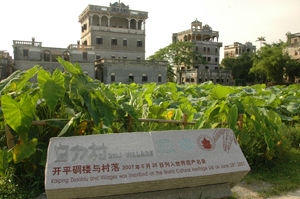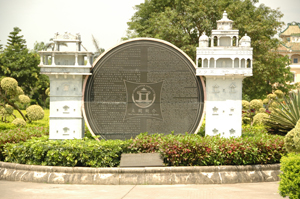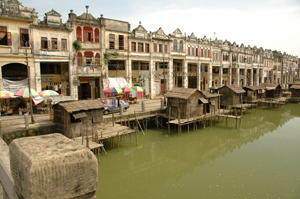Home > Destinations > Asia > China > 5-Days Guangdong Encounters



5-Days Guangdong Encounters
Guangzhou - Kaiping - Liannan - Yingde
廣州 ~ 開平 ~ 連南 ~ 英德
| Day 01 | Hong Kong 香港 ~Guangzhou 廣州 |
You will start your tour in a pleasant park on Shamian Island 沙面 in the ancient French-British concession along the Pearl River. Here, you can find native residents doing gymnastics, qi gong, and tai qi next to banyan trees a few centuries old. When you leave the park, you will discover by bike the preserved colonial architecture of the neighborhood. Notably, you will visit the Lady of Lourdes Church built by the French. Nowadays, the whole world seems to have forgotten that at one point in time, foreigners banned the Chinese from the island. Now, the area represents a repose from the commercial city. Young fiancés take their wedding photos in front of the old Victorian houses and locals stroll the large and tree-lined alleys in tranquility.
After traversing the major road that separates the island from the north side of the city, you will enter the ancient neighborhood of the Qing Ping Market 清平市場 with its history of selling dogs, cats, rodents, and owls for consumption. Even though the market is now closed because of the SARS epidemic, the surrounding neighborhood holds on to its character. Nearby, Chinese medicine shops sell a wide diversity of ginseng, dried scorpions and seahorses, dear antlers, and rare mushrooms. The smells of spices and fruit from stalls and clicks from mahjong players in houses with miniature private gardens enliven the area further.
Another road, modern and busy, also runs through this neighborhood. It is known for its clothes sellers who exclaim their merchandise’s qualities and clap their hands to attract customers. Literally a living theater, this area ends its performance with the Longjin Market 龍津市場 and its stalls of different sorts of fruit, meat, and fish for your delight.
Your biking will finish at the Ancestral Temple of the Chen Family 陳家祠. Built at the beginning of the 19th century by the inhabitants of 72 villages in the region, the temple demonstrates the region’s clan system. A large array of typical southern Chinese architecture, sculptures and paintings give homage to the Chen clan, a merchant clan very influential in the region. During this visit, you will learn a little bit more about the ancestor worship that exists in the country even now.
You will finish your day with a car journey to the Western Han Nanyue King’s Tomb Museum with its vast collection of funerary objects on three levels, considered as one of the best in the country. In the 1980s, people discovered the tomb of Zhao Mei (137-122 BC), the second king of Nanyue, the secessionist kingdom during the époque of the Western Hans (206 to 9 BC). The word “Yuenan” historically meant “south of the Yue” and became the word for Vietnam. The Yue are the ancestors of the southern Chinese ethnic groups: the Zhuang, Dong and Buyi.
Fortunately for visitors, the tomb was miraculously saved from pillaging during the years. The museum offers a superb collection of objects like Zhao Mei’s burial suit of jade and other pottery and furniture symbolizing the king’s importance. To think that this kingdom was on the periphery of the well-known Han Empire and often considered barbaric!
Overnight in Guangzhou
Optional: you would like the option to taste the dim sum of the region, we can arrange a tasting for you. Dim sum is a part of the famous Cantonese cuisine, one of the four main cuisines of China. Composed of small snacks of steamed dumplings and other items, the food often reminds a person of the Spanish tapas you might sample in a bar.
| Day 02 | Guangzhou 廣州 - Kaiping - Guangzhou 廣州 |
You will leave early Guangzhou (Canton) with your biking guide and driver and head early by car to the village of Chikan 赤坎, where homes constructed by overseas Chinese merchants are easily distinguishable with their grand pillars and picturesque balconies which locals now use to stand and stare curiously at travelers. Excellent examples of these traditional Cantonese homes are found along the banks of the river and make up a district which is often used as a backdrop for films set in the colonial period.
You will collect your bikes in the town centre and set off through the beautiful countryside passing through rice fields, bamboo forests and banana plantations where you will see locals busying themselves whilst chickens run free in the streets, giant water buffalo stand chewing endlessly on grass, and ducks swim in perfect lines in the ponds in which they are reared.
Option: You will get the opportunity to meet a duck farmer who will talk to you about his job and the impact of the local economy on his work. Ducks are bred in massive numbers to satisfy the growing demand from local restaurants who serve the specialty dish ‘Cantonese style roast duck’. Ducks are bred in massive numbers to satisfy the growing demand from local restaurants who serve the specialty dish ‘Cantonese style roast duck’.
You will stop first in Jinjiang village where you will visit what is considered the most beautiful diaolou in the region: the Ruishi Lou which is most notable for its byzantine architecture.
You will head then to the cluster of towers at Majianglong which according to local people provide a good Fengshui with the mountain in the back and Tanjiang river in the front.
Following the flagged path which winds through bamboo groves, you will discover a number of watchtowers from which you can admire the views of the surrounding lush, green countryside.
You will go back to Chikan for lunch (not included).
After lunch you will continue to Zili village you will be able to stop at the Li Garden 立園 which is made up of a number of villas built in a very flamboyant Italian style, reflecting the rest of the region or even the entire country.
You will go back to Chikan and drop off you bikes. Transfer back to Guangzhou by car.
The local system of social organization is based on grouping together the descendants of a single common ancestor located in the same geographical area, a system which influences ancestor worship as well as trade. Certain diaolou therefore are constructed by a number of villages who wish to prove the strength of their ancestral heritage line. On your way back to Guangzhou you will get the chance to visit Zili village 自力村 which is home to the greatest number of diaolou in the region. The towers here were built by the Fang clan who took inspiration from time spent in both Chicago and Malaysia.
Overnight in Guangzhou
(Ride up to 43 km).
Note: Chikan provides best options for lunch for you can skip it for lunch and reduce the total itinerary by 4km.
Difficulty: Moderate (flat all the way, one third of the cycling itinerary will be along national road)
Distance and journey time:
Guangzhou – Chikan (approx. 140 km): 2h (by car)
Chikan – Jinjiang (13km) by bike
Jinjiang – Majianglong (7km) by bike
Majianglong – Chikan (10km) by bike
Chikan – Li garden (7km) by bike
Li garden – Chikan (6km) by bike
Chikan – Zili village (8,5km): 20 min by car
Zi village- Guangzhou (approx. 135km): 2 h (by car)
| Day 03 | Guangzhou 廣州 - Liannan 連南 |
Drive to Liannan in the north of the province. Along the way you will cross the “Yingxi Corridor”, a vast expanse of karst formations (also known as sugarloaf mountains) typical to the south of China which continue to inspire poets, painters and photographers from the world over. The geological formations are systematically accompanied by a complex network of caves. A short boat-ride will take you to the heart of one of these caves which, by virtue of its ceiling, makes you think of cathedrals – a small opening at the very top of which provides a superb source of light that spills down onto the river!
Our next stop en route to Liannan will be to the “Thousand-year Village”, located around 15 kilometres (10 miles) from the town. It is home of the Yao minority, who totally number more than 2.6 million spread over the mountainous zones of five southern provinces (one of which is, of course, Guangdong) and even into Vietnam, Laos and Myanmar.
From here you will visit a village located on the side of a mountain. Its brick houses are covered by curved, black tile roofs and some even have small vegetable patches. Small channels run alongside the paved roads providing each home with water directly routed from the mountain. The majority of the old people wear traditional Yao clothing, and some sell all manner of ingredients connected to the Chinese Pharmacopeia… welcome to this enchanting location well off the beaten track!
The life of the Yao people is directly linked to religion, influenced strongly by Ancestor Worship and Taoism. You will be given an explanation of the remains of stone tombs (or Kistvaen), reserved for the Yao kings, which are found in the village. During the Cultural Revolution the Red Guards set about trying to make the tombs disappear because they were seen as unacceptable symbols of privilege accorded to the upper classes. Your visit will finish at the summit of the village with the exploration of a small temple dedicated to Ancestors, and from where you will be able to appreciate the exceptional panorama overlooking the forest of surrounding karst mountains.
You will spend the night, and eat dinner, with a host family.
Note: although well maintained and clean, the lodging conditions of the local houses are basic.
Distance and journey time:
Guangzhou – Liannan (approx. 250 km): 5h
| Day 04 | Liannan 連南 - Yingde 英德 |
Journey to Yingde. We will check into the Jiuzhou Resort, positioned at the foot of Tianmengou Mountain. The mountain is divided into 9 walking stations which correspond to differing degrees of difficulty. Your walk will take in the first 5 stations (taking between 2 and 3 hours depending on your pace), along which you can appreciate the small pools of crystalline water, the fresh air, the waterfalls and the splendorous view of the region from Station 5.
The feature that best characterises the resort, and which
merits a visit to this little-known region, is its relationship with nature and its “wellbeing” treatments. You will be sleeping in comfortable log cabins perched in the trees, and you can take the opportunity to relax in one of the many hot springs to compensate you for your earlier efforts. Treatments linked to Chinese medicine will be explained to you by your guide (hot stone massage, flower baths, acupressure…) and are available at the hotel (optional).
The day will end with a barbecue, some of the food coming from the resort’s vegetable garden.
Distance and journey time:
Liannan –Yingde (approx. 180 km): 4h30
| Day 05 | Yingde 英德- Guangzhou 廣州 - Hong Kong 香港 |
Today we visit the Tea Plantations which are characteristic of Yingde, where a famous black tea from the south of China is grown. Next a tasting session for this speciality which has a cocoa-like odour, takes on an amber colour during infusion and has a lightly peppery taste!
Originally consumed for medicinal purposes, tea rapidly became the favourite drink of the Chinese and the tea trade developed globally during the Tang Dynasty (618-907). With its rich diversity and complexity, tea culture can be compared to wine culture in the West. It is only the effects of having a little too much that differ wildly…
During your stay, you may have the opportunity to meet a local tea producer who can give you an explanation of the different families of tea: green tea, black tea, oolong tea, aromatic tea, white tea and compressed tea.
Return to Guangzhou airport and flight to your next destination.
Distance and journey time:
Yingde – Guangzhou (approx. 150 km): 2h30
Have a nice holidays!
Remarks :
Every effort will be made to adhere to the planned itinerary. However, due to weather conditions and reasons beyond our control, changes to the itinerary might occur, for which the company accepts no responsibility.
|
|---|
Newsletter Subscription: 訂閱最新旅遊資訊
Site Map · Privacy Policy 私隱政策(只附英文版)
© 2020 Exotic-Holidays.hk · All Rights Reserved
![]()